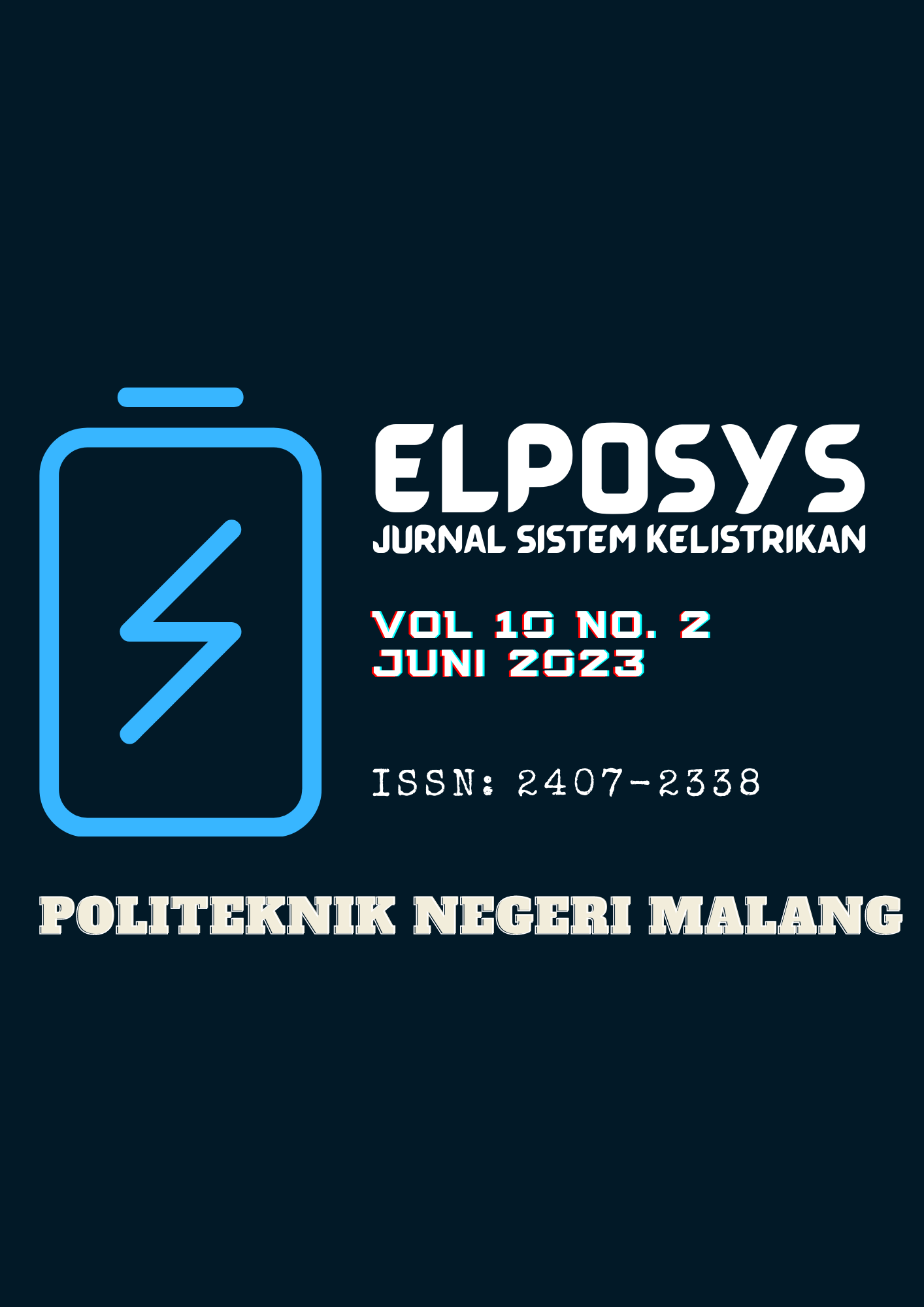Pengembangan Alat Estimasi Pola Peningkatan Kekotoran Panel PV
DOI:
https://doi.org/10.33795/elposys.v10i2.4691Keywords:
Photovoltaic; Sensor BH1750; Led; Glass; Effect of Dust on PVAbstract
Photovoltaic (PV) panels play a pivotal role in converting solar radiation into electrical energy. The efficiency of PV panels is susceptible to the impact of shadows and accumulated dirt on the panel surfaces. This research aims to establish a correlation between the level of dirt accumulation and the resultant power generation. The methodology employed involves a comparative analysis of power output from PV panels under clean and dusty conditions. To quantify the increase in dust over a 3-day data collection period, a glass surface was exposed outdoors to collect dust, serving as a reference for comparison with the PV panel surface. The glass, containing accumulated dust, was then subjected to data retrieval using an LED as a light source. A light intensity sensor (BH1750) was employed to measure the decrease in light intensity as dust coverage increased on the glass surface over time.The results of the PV fouling test, utilizing 10 grams of dust, indicate a relatively stable voltage generation with only a 0.8-volt loss. In contrast, the current generated experienced losses of 0.28 amperes before and after fouling. These losses significantly impact the overall power generation capacity of the PV panel. This research sheds light on the importance of mitigating dust accumulation on PV surfaces to optimize and sustain efficient solar energy conversion.
References
R. R. Al Hakim, “Model Energi Indonesia, Tinjauan Potensi Energy Terbarukan Untuk Ketahanan Energi Di Indonesia: Literatur Review,” ANDASIH Jurnal Pengabdian Kepada Masyarakat, vol. 1, no. 1, 2020.
R. Duanaputri, I. Heryanto/Eryk, M. F. Sajidan, M. F. Hakim dan A. L. Wardani, “Sistem Monitoring Online Dan Analisis Perfomansi Plts Panel Surya Monocrystalline 100 Wp Berbasis Web,” Elposys, vol. 10, no. 1, p. 1–6, 2023.
D. A. Panunggul, M. S. Boedoyo dan N. A. Sasongko, “ANALISA PEMANFAATAN ENERGI TERBARUKAN DI UNIVERSITAS PERTAHANAN SEBAGAI PENDUKUNG KEAMANAN PASOKAN ENERGI (STUDI KASUS: ENERGI SURYA DAN ANGIN),” Jurnal Ketahanan Energi Universitas Pertahanan, vol. 4, no. 2, p. 75–91, 2018.
T. Hasannuddin, S. Aiyub dan A. B. Pulungan, “Efisiensi Penggunaan Energi Listrik pada Sistem Interkoneksi 150 Kv Nanggroe Aceh Darussalam Menggunakan Distributed Generation,” JURNAL LITEK: Jurnal Listrik Telekomunikasi Elektronika, vol. 14, no. 1, p. 13–17, 2017.
B. P. Asmara, “Tinjauan Pengukuran Keluaran Photovoltaic (Pv) Terhadap Pengaruh Kekotoran Debu Dan Beban,” dalam Seminar Nasional Teknologi, Sains Dan Humaniora, 2021.
A. R. Rois, N. Gunawan dan B. Chayun, “Analisa Performansi dan Monitoring Solar Photovoltaic System (SPS) Pada Pembangkit Listrik Tenaga Surya Di Tuban Jawa Timur,” Jurnal Teknik Pomits, p. 1–8, 2017.
A. Julisman, I. D. Sara dan R. H. Siregar, “Prototipe Pemanfaatan Panel Surya Sebagai Sumber Energi Pada Sistem Otomasi Atas Stadion Bola,” KITEKTRO: Jurnal Online Teknik Elektro, vol. 2, p. 35–42, 2017.
I. Kholiq, “Pemanfaatan Energi Alternatif Sebagai Energi Terbarukan Untuk Mendukung Subtitusi BBM,” Jurnal IPTEK, vol. 19, no. 2, p. 75–91, 2015.
G. P. C. Handani, B. S. Gumilang dan A. Zuroida, “Perancangan Pembangkit Listrik Tenaga Surya (PLTS) untuk Suplai Daya Sistem Pemberian Pakan Ikan Otomatis,” elposys, vol. 9, no. 3, p. 183–187, 2022.
H. Kawamura, K. Naka, N. Yonekura, S. Yamanaka, H. Kawamura, H. Ohno dan K. Naito, “Simulation of I–V characteristics of a PV module with shaded PV cells,” Solar Energy Materials and Solar Cells, vol. 75, no. (3–4), p. 613–621, 2003.
S. Khatoon, Ibraheem dan M. F. Jalil, “Analysis of solar photovoltaic array under partial shading conditions for different array configrations,” dalam 2014 Innovative Applications of Computational Intelligence on Power, Energy and Controls with Their Impact on Humanity (CIPECH), 2014.
A. Rajagukguk, D. C. Riawan dan M. Ashari, “Optimization of photovoltaic farm under partial shading effects using artificial intelligent based matrix switch controller,” dalam 2015 2nd International Conference on Information Technology, Computer, and Electrical Engineering (ICITACEE), 2015.
I. A. Setiawan, I. S. Kumara dan I. W. Sukerayasa, “Analisis Unjuk Kerja Pembangkit Listrik Tenaga Surya (Plts) Satu MWP Terinterkoneksi Jaringan di Kayubihi, Bangli,” Teknologi Elektro, vol. 13, no. 1, 2014.
F. Felycia, “SOLAR CELL TRACKING SYSTEM DENGAN LUX METER BERBASIS ARDUINO UNO R3,” PROSISKO: Jurnal Pengembangan Riset Dan Observasi Sistem Komputer, vol. 7, no. 2, p. 132–140, 2020.
A. H. Santoso, M. Saputra dan F. N. R. Hamka, “PLTS sebagai Backup Supply pada Plant Hidroponik Nutrient Film Tehcnique (NFT) Berbasis IoT,” Elposys: Jurnal Sistem Kelistrikan, vol. 10, no. 1, p. 19–23, 2023.
A. Julisman, I. D. Sara dan R. H. Siregar, “Prototipe Pemanfaatan Panel Surya Sebagai Sumber Energi Pada Sistem Otomasi Atas Stadion Bola,” KITEKTRO: Jurnal Online Teknik Elektro, vol. 2, p. 35–42, 2017.
Downloads
Published
How to Cite
Issue
Section
License
Copyright (c) 2023 Elposys: Jurnal Sistem Kelistrikan

This work is licensed under a Creative Commons Attribution-NonCommercial 4.0 International License.








